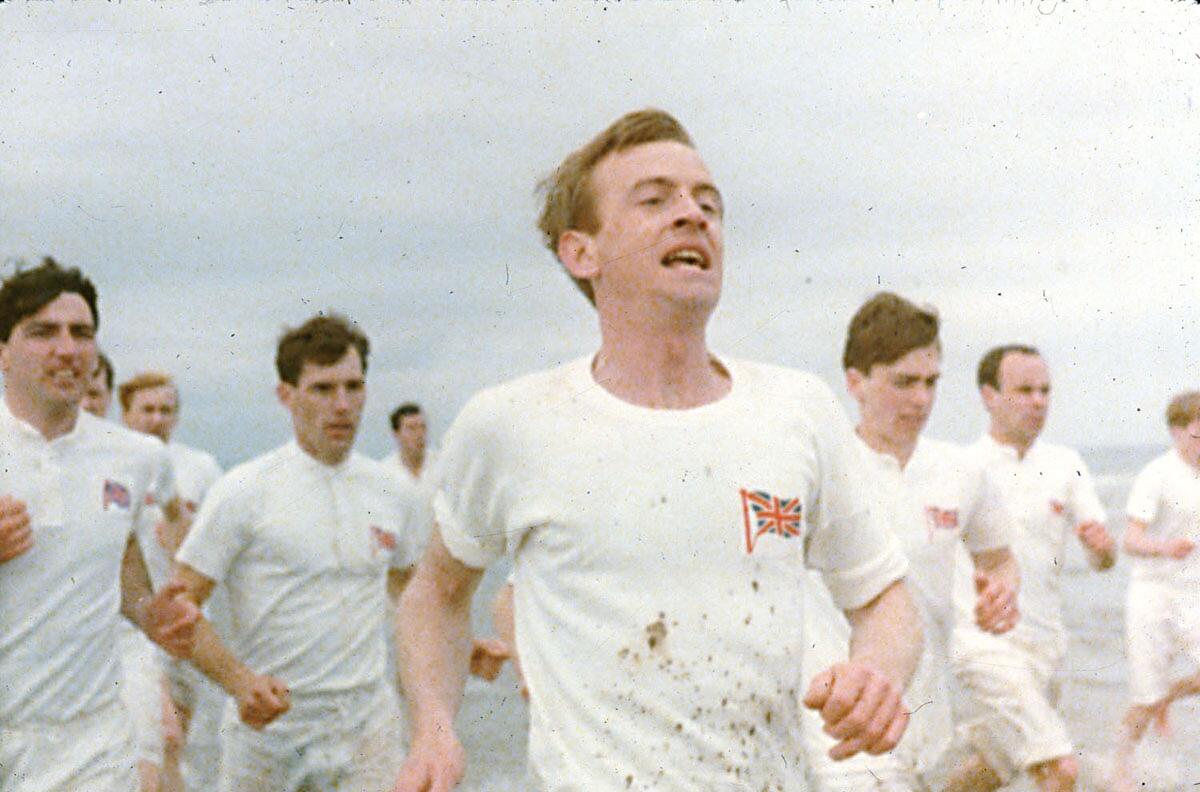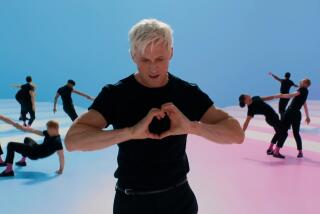From the Archives: ‘Chariots of Fire’ bursts from the screen

- Share via
“The public does not know what it wants. Impose on it your decisions, your delight.”
These firm words were director Robert Bresson’s; he might’ve been speaking to British director Hugh Hudson and producer David Putnam. How could a public know that a film with the damaging title “Chariots of Fire” could contain such delights; that it was the sort of movie we’d all almost given up hope of seeing. Majestic is a semi-embarrassing word, but it applies, so does masterful exultant, triumphant and joyful.
“Chariots of Fire” (opening Friday at the Regent, Westwood) has sports as its backbone and passion as its fueling emotion. It traces the parallel lives of two athletes — or, more correctly, two extraordinary men to whom running was a necessary part of life — who became part of the remarkable British track and field team at the 1924 Olympics.
They were the dark and the light; the fiercely competitive Harold Abrahams, to whom running was a weapon against the snobbery and anti-semitism he encountered at Caius College, Cambridge (and before), and Eric Liddell, the son of a Scottish missionary, whose will to run came from a passionate spirituality.
Steadily, a mite awkwardly at first, the twin stories build. The awkwardness comes from a break at the opening. It begins at a funeral in 1978, then shifts back in memory to 1924, at the edge of a misty beach in France where, like horses running in the sea out of pure joy, the British Olympic runners are running barefooted, each in his distinctive style. Of Liddell it was written at the time that he ran “head towards heaven, body almost in a backwards lean.” Abrahams is deadly serious; his mind could be a pedometer clicking off the miles. Then there is young lord Andrew Lindsay, one of those pink-cheeked, dangerously handsome men the peerage still turn out, who manages to let all effort look like a lark.
And under the scene, the first hint that this is something other than an old-fashioned film. As the noble piano theme is stated there are nervous electronic sounds which catch the runners’ tension and transmit it. The work of Vangelis Papathanassiou, who uses only his first name in his composing and conducting, this is an original and breathtaking score. Then the scene shifts backwards again. We are in 1919, beginning to follow the lives of the men who will converge on the Olympic competition in Paris in 1924.
Set in a simpler era, if in a self-centered fashion we assume any period before Los Alamos was somehow simpler, “Chariots” tackles old-fashioned subjects: a man’s essential character, the question of a moral issue, justice, goodness, gallantry. Director Hudson, with his first feature, screenwriter Colin Welland (“Yanks”) and producer Puttnam take these abstracts and breathe hot, urgent life into them.
There is the worry that in describing the film’s issues it will begin to sound like this generation’s “Wilson,” high-intentioned and good for you. There’s no denying that though “Wilson” is a serious effort, it was also traumatically heavy sledding to see as a child. Miraculously, “Chariots of Fire’s” subjects and its strengths as a film merge. David Watkin’s haunting, glowing photography in the pure cinema of the running sequences under Terry Rawlings’ editing make them burst from the screen with almost intoxicating excitement. “Chariots’” blend of idealism and passion makes a film you want to share with young moviegoers.
Screenwriter Welland begins with the portrait of just what World War I cost its victors. The London of 1919 is haunted as much by the crippled specters of the wounded who returned as by the almost endless list of names on new bronze plaques in public places. Then, in the paneled gentility of Cambridge, our principals assemble.
Harold Abrahams may be looked down upon as a son of a Lithuanian Jew by the masters who guard Caius (pronounced “Keys”) and Trinity colleges, but we understand in a rush why his fellow Cambridge classmates take to him. Athletics is only part of it. Abrahams is almost an F. Scott Fitzgerald hero one ocean away; a mixture of less-than-upper-class rage, ability and determination, in the absurdist trappings of Gilbert and Sullivan.
Much later, Eric Liddell’s grade-school headmaster recalled his young Scot: “His standards had been set for him long before he came to school. There was no pride or fuss about him, but he knew what he stood for.” There is no pride or fuss about Liddell in the film either, which is what makes his character so memorable.
Lord Andrew Lindsay’s role sets off the other two. It’s really only in retrospect that you realize his importance. He shows up to pace Abrahams in his astonishing bid to break a 700-year standing record at Cambridge not out of rivalry but as an upper-class gesture of support. Lindsay is all that is best about that group: its throwaway wit, its grace and its gallantry.
The filmmakers have chosen new faces and magnificent new actors as the British athletes and their friends. Ben Cross plays Harold Abrahams, Ian Charleson is the impassioned Liddell, Nigel Havers is Lindsay. All three are simply remarkable: Cross and Charleson are equally matched in fervor, Havers is effortless as the gallant Lindsay. The film’s women are newcomers too, Alice Krige as the stage beauty who catches Abrahams’ eye and Cheryl Campbell in the somewhat thankless role of Liddell’s missionary sister.
All the actors playing the athletes are substantially older than their characters, yet for some reason they don’t appear to be. There may be a trick about period films: We don’t notice as quickly when characters of the 1920s look a little older. That’s our father’s or grandfather’s era. Since we know how they could never really have been young (not our kind of young), we mentally assign even to young people a mid-30s maturity. All the actors look like runners, except in one of the two cameo performances by Americans Dennis Christopher and Brad Davis, part of the dreaded American juggernaut. Davis is in beautiful condition but he looks like a gymnast or a boxer, not a runner.
Besides its virtues of time and place, “Chariots of Fire” has a notable beauty in its character actors. The poisonous discussions between the two Cambridge college masters over Abrahams’ unseemly pursuit of first place are entrusted to Sir John Gielgud and director-actor Lindsay Anderson. Ian Holm, who plays Sam Mussabini, a coach before the time when coaches were part of every Olympic hopeful’s equipment, is too little known in American films. He and Ben Cross create some of the film’s most human moments.
To answer the unasked question: How is the film for the nonathletic? Hard to believe in this world of Adidas and Ace bandages, but there are still those of us who would not run for a bus. Yet the filmmakers have gone beyond even that barrier, the pain of watching running, to catch us as tightly as any life-long fan.
The idea for the film came to producer Puttnam when he rented a house in Los Angeles and found in it only “The Official History of the Olympic Games” to read. He became intrigued by notable points of the 1924 Games: Eric Liddell’s refusal to run at his distance when the heats for his race were held on Sunday; Harold Abrahams competing against a quartet of Americans believed to be invincible in the 100 meters, something Britain had never won.
His film is sumptuous, the work, apparently, of a platoon of art directors. Roger Hall is the supervising art director, and as art directors per se there were Jonathan Amberston, Andrew Sanders, Len Huntingford and Anna Ridley. It is a monumental job; the film has the delights of the era (the chrome and wood-paneled car at Lord Lindsay’s estate which sweeps up to take the leading actress back to London) without appearing to dwell on them, and the nobility that is Cambridge University is as beautiful as its restrictions are hateful.
Because “Chariots’” essence is not easily described, because it speaks about values and courage beyond the physical, there seems to be some worry it will be difficult to market. You might hope this underestimates the audience for the finest moments a screen can achieve — you might well hope.
More to Read
Only good movies
Get the Indie Focus newsletter, Mark Olsen's weekly guide to the world of cinema.
You may occasionally receive promotional content from the Los Angeles Times.






